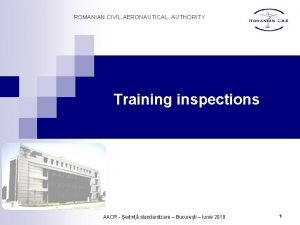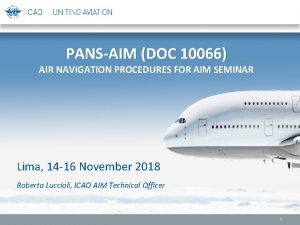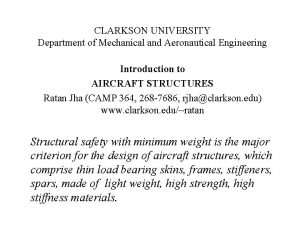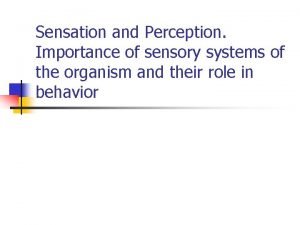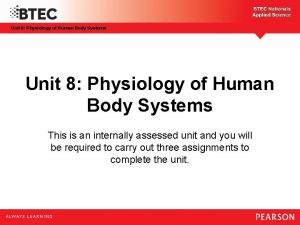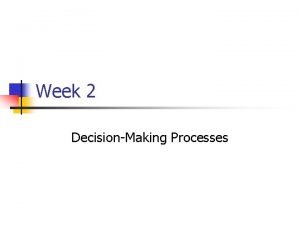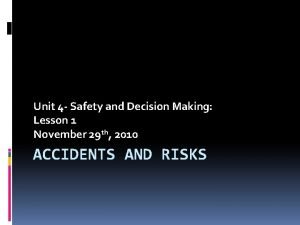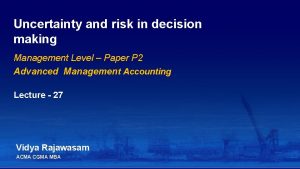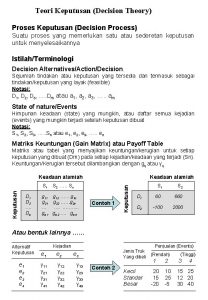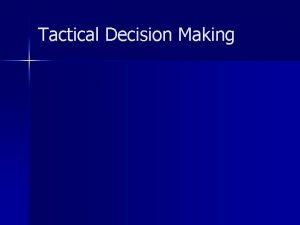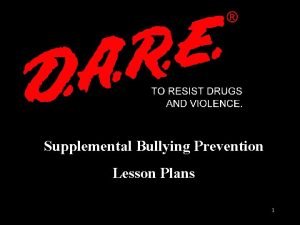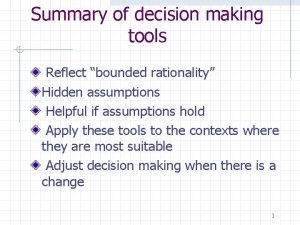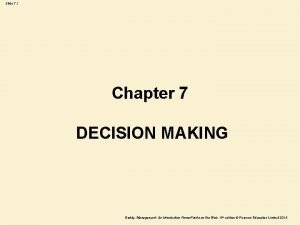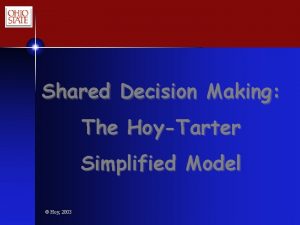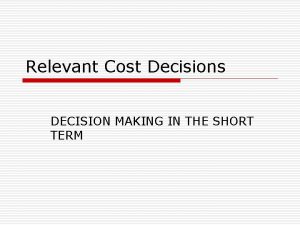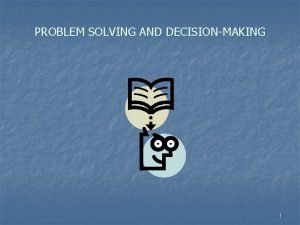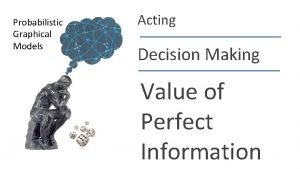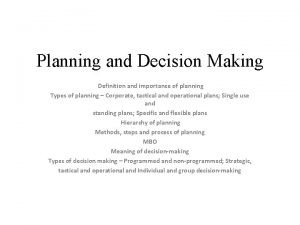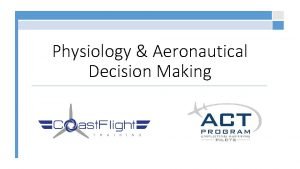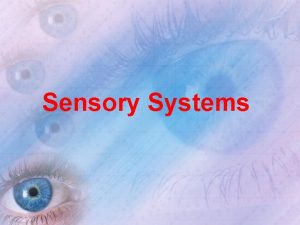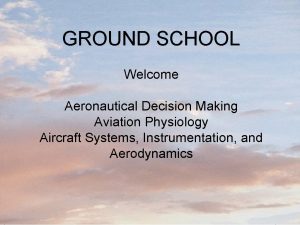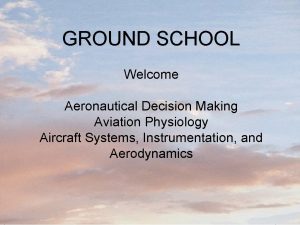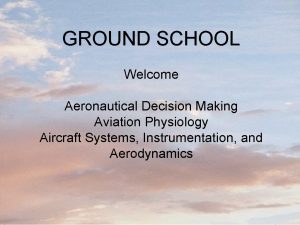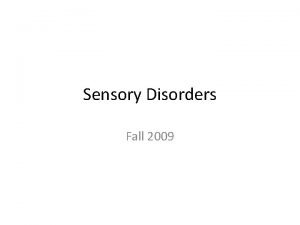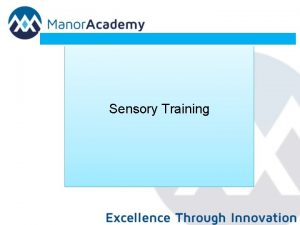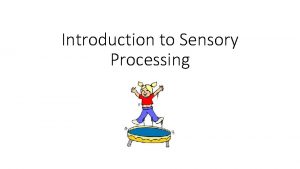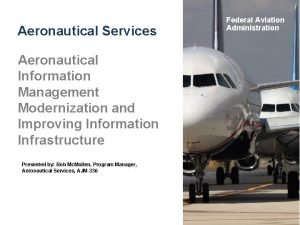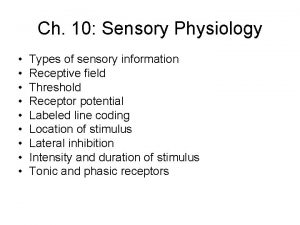Intro to Physiology Aeronautical Decision Making Sensory Systems





























































- Slides: 61

Intro to Physiology & Aeronautical Decision Making

Sensory Systems for Orientation • Visual System • Vestibular System • Postural • Auditory Cues © 2015 Coast Flight Training. All Rights Reserved.

Visual System • Primary method of orientation • Responsible for 80% of flight information received • Works similar to a camera focusing light through a lens • Sends signals to the brain via an optic nerve • Subject to visual illusions and contains blind spots © 2015 Coast Flight Training. All Rights Reserved.

Visual System • Light enters the eye through the cornea • It then passes through the lens and falls on the retina • Sensors located on the retina convert light into electrical impulses that are sent to the brain via the optic nerve © 2015 Coast Flight Training. All Rights Reserved.

Visual System • Rods • Sensors concentrated on the peripheral of the retina • Highly sensitive to light • Primarily used during low light conditions, at night • Do not detect color • Contains rhodopsin, visual purple • Optic Nerve • Contains no rods or cones • Result in loss of vision © 2015 Coast Flight Training. All Rights Reserved.

Visual System © 2015 Coast Flight Training. All Rights Reserved.

Visual System – Blind Spots © 2015 Coast Flight Training. All Rights Reserved.

Black and White Vision • Images cast on the retina are converted from light energy into electrical impulses then sent to the brain • Rods contain the protein rhodopsin which in turn contains a derivative of Vitamin A • Located on the periphery of the eye, the rods are 10, 000 times more sensitive to light than the fovea • A healthy human has about 120 million rods in each eye • Rods are light sensitive and used for viewing in low light conditions, such as night time © 2015 Coast Flight Training. All Rights Reserved.

Color Vision Color sensitive cells in the retina are called cones There are 3 types of cones: Red, green, blue 6 million cones add color detail to images sensed by the rods The photo pigment in the cones responsible for color are called rhodopsin Each type of cone transmits light into wavelengths of light energy sent to the brain • Cones require much higher light energy than rods to elicit a response • They are used for detailed viewing during day light hours • • • © 2015 Coast Flight Training. All Rights Reserved.

Limits to the Visual System • Adjusting from high light to low light conditions • Vitamin A deficiency and its affect on vision • Optical illusions • Daylight viewing vs. night time viewing © 2015 Coast Flight Training. All Rights Reserved.

Socrative Multiple Choice 1 • Which Mineral is Important for the Eyes to Function? • • Vitamin A Omega 3 Vitamin C Grape Soda © 2015 Coast Flight Training. All Rights Reserved.

Vestibular System • The inner ear houses 3 semi-circular canals • Fluid in the canals orientate the body along the three main axes • These axes correspond to the axes of pitch, roll and yaw in an aircraft • This system falls secondary to the ever-dominant visual system • False signals can overwhelm an untrained pilot © 2015 Coast Flight Training. All Rights Reserved.

Location of Vestibular System © 2015 Coast Flight Training. All Rights Reserved.

Semicircular Canals and Corresponding Axes © 2015 Coast Flight Training. All Rights Reserved.

Inside the Semicircular Canal © 2015 Coast Flight Training. All Rights Reserved.

Fluid in Motion Starting a Turn © 2015 Coast Flight Training. All Rights Reserved.

Loss of Sensations © 2015 Coast Flight Training. All Rights Reserved.

Postural and Auditory • Postural uses the body’s center of gravity • A person can be upside down, but if pulling 1 positive G load, it will feel like sitting normally right side up • Auditory uses aural queues when other senses are limited • Engine sound (low pitch = airspeed reduction) • Wind speed (increase in wind noise = airspeed gain) © 2015 Coast Flight Training. All Rights Reserved.

Postural Orientation © 2015 Coast Flight Training. All Rights Reserved.

Illusions in Flight • Vestibular Illusions • When visual cues are not received and the body has to rely on information being sent from the vestibular nerve • Visual Illusions • Due to optical illusions created by the eyes. Experienced pilots are aware of these illusions and are not as susceptible © 2015 Coast Flight Training. All Rights Reserved.

Spatial Disorientation • When a pilot becomes unaware of his or her position due to a disharmony between multiple senses • When this occurs, full focus should be placed on the flight instruments in order to maintain safe flight attitudes © 2015 Coast Flight Training. All Rights Reserved.

Postural and Auditory • Rapid acceleration can feel like pitching up • This is dangerous during low visibility takeoffs and go around due to proximity to the ground • While accelerating, the pilot might falsely sense an over pitching moment and incorrectly pitch down © 2015 Coast Flight Training. All Rights Reserved.

The Leans • Discussed before, during long durations of constant motion, the fluid can re-settle in the canal • This can lead to a sense of not turning during a turn • When the pilot rolls wings level, the fluid will begin flowing in the opposite direction, giving the false sensation of beginning another turn • This is dangerous because he will try to correct by attempting to roll until he feels like he is wings level, when in fact he will be in a turn © 2015 Coast Flight Training. All Rights Reserved.

Coriolis Illusion • Occurs when the fluid in a canal of the same axis of motion, begins to flow at the same rate as the motion • Due to rapid head movement fluid in another canal will begin to move giving the false sense of motion in the new canal’s axis • Pilot must develop an instrument scan which minimizes head movement © 2015 Coast Flight Training. All Rights Reserved.

Inversion Illusion • Due to abrupt level off from climb • Body feels as if it were tumbling backwards • Pilot might incorrectly adjust for level by pushing nose down into a dangerous attitude © 2015 Coast Flight Training. All Rights Reserved.

Elevator Illusion • Due to strong updraft or downdraft • Pilot feels as if in a climb or descent © 2015 Coast Flight Training. All Rights Reserved.

Graveyard Spirals • Prolonged turns lead to sense of not turning • Aircraft begins to descend in turn and pilot pulls back on yoke • Because he is pulling back but not reducing bank, the descending turn steepens into a tight spiral • Proper recovery is to roll level wings (using the Attitude indicator) and slowly recover from the dive, reducing throttle to idle to avoid exceeding VNE © 2015 Coast Flight Training. All Rights Reserved.

Graveyard Spin • After recovery from a spin • Pilot feels as if spinning in opposite Direction and will incorrectly try to recover from a non-existent spin, thus causing another and crashing © 2015 Coast Flight Training. All Rights Reserved.

Coping with Spatial Disorientation • Do not make abrupt movements • Always be aware of the state of the aircraft • Understand the cause of the illusion • Correct based off of the aircraft instruments • Cross-check instruments for accuracy © 2015 Coast Flight Training. All Rights Reserved.

Visual Illusions - Autokinesis • In a dark sky with few references • A single light, or point of light to focus on • Eye cannot fully focus and will begin rapid movement • The object will appear to move • Pilot might try to maintain attitude position and chase the light © 2015 Coast Flight Training. All Rights Reserved.

Visual Illusions – False Horizon • Stars, boats, or sloping clouds create a new horizon • Pilot tries to align aircraft with new horizon © 2015 Coast Flight Training. All Rights Reserved.

Empty-Field Myopia • Occurs at night • When the eyes have nothing to focus on, the eye will default to focus 4 feet in front of you • This inhibits that ability to see objects far away unless the pilot forcibly tries to focus on other distances © 2015 Coast Flight Training. All Rights Reserved.

ICEFLAGGS • • • Inversion Coriolis Illusion Elevator Illusion False Horizon Leans Autokinesis Graveyard Spiral Graveyard Spin Somatogravic Illusion © 2015 Coast Flight Training. All Rights Reserved.

Socrative Short Answer 1 • If I focus on a light during the middle of the night, it appears to me that it starts moving. What illusion am I experiencing? © 2015 Coast Flight Training. All Rights Reserved.

Other Illusions… © 2015 Coast Flight Training. All Rights Reserved.

Runway Width • A narrow runway makes pilot appear high and fly a lower than normal approach, possibly striking terrain • A wide runway makes the pilot appear low and fly a higher than normal approach, possibly over shooting the runway © 2015 Coast Flight Training. All Rights Reserved.

Runway Slope • An up-sloping runway makes pilot appear high and fly a lower than normal approach, possibly striking terrain • A down-sloping runway makes the pilot appear low and fly a higher than normal approach, possibly over shooting the runway © 2015 Coast Flight Training. All Rights Reserved.

© 2015 Coast Flight Training. All Rights Reserved.

Featureless Terrain / Black Hole Approach • Lack of terrain makes pilot appear high • Pilot flies lower approach • Approaching a runway at night with little or no other light references make it difficult to judge distance, altitude and proper glide path • Use your PAPI or VASI whenever able! © 2015 Coast Flight Training. All Rights Reserved.

Haze and Fog Effects • Haze makes object appear further away • Pilot feels higher on an approach and flies lower • Fog • Flying into fog creates a pitching up illusion • Pilot starts to fly lower © 2015 Coast Flight Training. All Rights Reserved.

Coping With Visual Illusions • Understand illusions • Anticipate illusions • Fly higher if possible when landing • Rely on the instruments © 2015 Coast Flight Training. All Rights Reserved.

Socrative Short Answer 2 • If I approach to land on an upsloping runway, I will appear to be ______ on approach, therefore I should attempt to fly slightly _____ than what appears. © 2015 Coast Flight Training. All Rights Reserved.

Physiological and Psychological Factors © 2015 Coast Flight Training. All Rights Reserved.

Affects of Stress • Stress is a good thing (Eustress) in the right amount • Too much stress can suddenly cause human performance to deteriorate (distress) • Physical, psychological, and physiological stressors © 2015 Coast Flight Training. All Rights Reserved.

Affects of Fatigue • Acute fatigue vs. chronic fatigue • Inability to focus • Reduction in mental and physical ability • Increases frequency of mistakes • Impairs judgment • Can have deadly consequences © 2015 Coast Flight Training. All Rights Reserved.

Affects of Alcohol • Histotoxic hypoxia • Impairs judgment • Decreased reaction time • Increases fatigue • Increased effects at higher altitude • Regulations regarding alcohol… • Crew member requirements • Passengers requirements © 2015 Coast Flight Training. All Rights Reserved.

Drugs • Illegal drugs (narcotics, opiates etc. ) • Prescription medications • Over-the-counter (OTC) medications • Most drugs not tested at high altitudes • Always consult an Aviation Medical Examiner (AME) © 2015 Coast Flight Training. All Rights Reserved.

Decompression Sickness Cause: • Exposure to low barometric pressures cause nitrogen (normally dissolved) to form bubbles in various parts of the body • Bends (joints) • Chokes (lungs) • Skin Bends (skin) • Neurologic (brain/spinal cord) DCS After Scuba Diving: • Allow body sufficient time to rid itself of excess nitrogen Recommended waiting time: • 12 hours after • < 8, 000’ (no decompression stop) • 24 hours after • > 8, 000’ (no decompression stop) • Any dive requiring decompression stop

IMSAFE Self-Checklist • I – Illness • Do not fly due to sinus and ear blockages • M – Medication • Even non drowsy medication has side effects at high altitudes • S – Stress • Acute Stress: Due to immediate threat • Chronic Stress: Levels that create intolerable burden • Some stress is good, too much is detrimental • A – Alcohol • Regulations vs. personal minimums • F – Fatigue • Acute: Short periods of time • Chronic: Long periods of fatigue • E – Eating • Maintain a healthy diet and stay hydrated © 2015 Coast Flight Training. All Rights Reserved.

Hypoxia • Hypoxic • Insufficient oxygen available to the body as a whole • Hypemic • Blood is unable to transport a sufficient amount of oxygen to cells • Histotoxic • Inability of cells to effectively use the oxygen • Stagnant • Oxygen-rich blood in the lungs is not moving to the tissues that need it © 2015 Coast Flight Training. All Rights Reserved.

Socrative Short Answer 3 • What type of Hypoxia will I experience if I sit still for a long period of time? © 2015 Coast Flight Training. All Rights Reserved.

Oxygen Requirements – 91. 211 © 2015 Coast Flight Training. All Rights Reserved.

Socrative Short Answer 4 • At what altitude is everyone required to have oxygen on the aircraft? © 2015 Coast Flight Training. All Rights Reserved.

Cockpit Resource Management • Organized cockpit • • Have all publications readily available and organized neatly Fold all charts neatly to the page that shows route of flight Dial in all frequencies and navigation frequencies before workload increases If using GPS, have route programmed before departure Be familiar with where everything is located in the cockpit Be familiar with the entire route and airport approaches Take more than one pen or pencil © 2015 Coast Flight Training. All Rights Reserved.

Crew Resource Management • Use inside and outside resources for help • • • Passengers and Crew Members Air Traffic Control Flight Service Station Dispatchers Other Aircraft © 2015 Coast Flight Training. All Rights Reserved.

Hazardous Attitudes • Macho: “I can do it. ” • Invulnerability: “It won’t happen to me. ” • Impulsivity: “Do it quickly. ” • Anti-Authority: “Don’t tell me. ” • Resignation: “What’s the use? ” © 2015 Coast Flight Training. All Rights Reserved.

Pave Checklist • Pilot • Aircraft • en. Vironment • External Pressures © 2015 Coast Flight Training. All Rights Reserved.

5 P’s • The Plane • The Pilot • The Passengers • The Programming © 2015 Coast Flight Training. All Rights Reserved.

Decide Model • Detect a problem • Estimate the need to react • Choose a course of action • Identify possible solutions • Do the necessary actions • Evaluate the effect of the action © 2015 Coast Flight Training. All Rights Reserved.

Risk Management • Flight Risk Assessment Tools • The Swiss Cheese Model of Accident Theory • When in doubt – DON’T GO OUT © 2015 Coast Flight Training. All Rights Reserved.

References • Jeppesen Private Pilot Flight • Pilot’s Handbook of Aeronautical Knowledge • Airplane Flying Handbook © 2015 Coast Flight Training. All Rights Reserved.
 Objectives of decision making
Objectives of decision making Slidetodoc.com
Slidetodoc.com Chapter 2 economic systems and decision making
Chapter 2 economic systems and decision making Chapter 2 economic systems and decision making
Chapter 2 economic systems and decision making How do information systems aid in decision making
How do information systems aid in decision making Chapter 2 economic systems and decision making
Chapter 2 economic systems and decision making Decision support systems and intelligent systems
Decision support systems and intelligent systems Invest in aeronautical production in colombia
Invest in aeronautical production in colombia Aeronautical information exchange model
Aeronautical information exchange model Utm automotive engineering
Utm automotive engineering Aeronautical information exchange model
Aeronautical information exchange model Aeronautical communication ppt
Aeronautical communication ppt Aeronautical engineering
Aeronautical engineering Romanian civil aeronautical authority
Romanian civil aeronautical authority Doc 10066
Doc 10066 High altitude aeronautical platforms
High altitude aeronautical platforms International council of the aeronautical sciences
International council of the aeronautical sciences Clarkson mechanical engineering
Clarkson mechanical engineering Aeronautical information exchange model
Aeronautical information exchange model Aeronautical information exchange model
Aeronautical information exchange model Ais aena
Ais aena Sensory systems
Sensory systems Unit 8: physiology of human body systems assignment 1
Unit 8: physiology of human body systems assignment 1 Decision table and decision tree examples
Decision table and decision tree examples Youth involvement
Youth involvement Social ethics
Social ethics Systematic decision making process
Systematic decision making process What doing our country
What doing our country Using recursion in models and decision making
Using recursion in models and decision making Using recursion in models and decision making sheet 3
Using recursion in models and decision making sheet 3 Paced decision making
Paced decision making Unit 4 lesson 1 decision making
Unit 4 lesson 1 decision making Decision making to improve marketing performance
Decision making to improve marketing performance Types of decision making
Types of decision making Higher business management
Higher business management Contribution payoff table
Contribution payoff table Decision categories
Decision categories Descriptive role of marketing research
Descriptive role of marketing research Critical decision making model police
Critical decision making model police Contoh soal decision tree
Contoh soal decision tree Tactical decision making
Tactical decision making What is the dare decision making model
What is the dare decision making model Rational decision making model
Rational decision making model Mintzberg's modes of strategic decision making
Mintzberg's modes of strategic decision making Paced decision making
Paced decision making Chapter 6 prices and decision making assessment answers
Chapter 6 prices and decision making assessment answers Decision making conditions
Decision making conditions Sbdm committee
Sbdm committee Hoy and tarter decision making model
Hoy and tarter decision making model Decision making and relevant information
Decision making and relevant information Decision making and relevant information
Decision making and relevant information Decision making in healthcare
Decision making in healthcare Abcde decision making model
Abcde decision making model Judgement and decision making reasoning
Judgement and decision making reasoning Best books on problem solving and decision making
Best books on problem solving and decision making Individual and group decision making
Individual and group decision making What graphical model is appropriate for decision-making?
What graphical model is appropriate for decision-making? Individual and group decision making
Individual and group decision making Habitual decision making adalah
Habitual decision making adalah List the steps in the paced decision-making process
List the steps in the paced decision-making process Paced decision model
Paced decision model Stop method of moral decision making
Stop method of moral decision making













